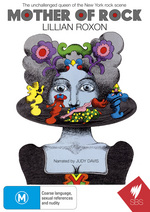The unchallenged queen of the New York rock scene On her way to New York in 1959, a young Australian journalist Lillian Roxon, who’d grown up as an impressionable teenager in the town of Brisbane awash with American servicemen, stopped in Hawaii to interview Colonel Tom Parker. Symbolically this would mark the beginning of Lillian’s passion for Rock’n’Roll. Ten years later, she was the queen of New York’s coolest club, Max’s Kansas City, and would write the first ever Rock Encyclopedia. Roxon lived close to the Factory and was friends with Warhol and his superstars and the rock crowd who increasingly flocked to Max’s to be seen and to hear the new sounds of Alice Cooper, Iggy Pop, and the New York Dolls. At Max’s, Pop Art collided with rock and roll and ultimately gave rise to the birth of Punk. Mother of Rock: Lillian Roxon shines a light into the decadent world of Max’s, and Lillian’s place in documenting the emerging rock revolution as it rolled over the US in the 1960s and early 1970s. The film features an amazing cast including new interviews with Iggy Pop. Alice Cooper, Germaine Greer, Danny Fields, Lisa Robinson (Vanity Fair), Lenny Kaye (the Patti Smith Group) , friend Richard Neville (of the Old Bailey Oz magazine trial notoriety), her former boss Derryn Hinch, rock photographers Leee Black Childers and Anton Perich, and many of Lillian’s closest personal friends including Booker Prize nominated author David Malouf and film producer Margaret Fink. Lillian came from a Jewish family who had fled Mussolini's Italy for the suburban safety of Brisbane, Australia. She arrived at Sydney University in 1949 and immediately aligned herself with the anti-authoritarian, anarchist Push movement. She subsequently embarked on a career as a journalist for the tabloid Weekend, writing fresh and inventive pieces that would distinguish her as a forerunner of the New Journalism. In 1959 she left provincial Australia for New York where she became increasingly fascinated with the burgeoning cultural phenomenon of popular music. In the mid 1960s, together with close friend Linda Eastman, she covered the British invasion of the US with stories on The Rolling Stones and The Beatles. Danny Fields befriended her after a press conference where he was impressed by the audacity and intelligence of the questions she threw at Brian Epstein. Danny and Lillian became the “king and queen bee” of Max's Kansas City where they had their own table in the backroom staked out by Andy Warhol and his Superstars. By 1970 Max’s Kansas City was the coolest place to be in New York – patrons included John and Yoko, The Rolling Stones, The Doors, Janis Joplin and Hendrix, the young Patti Smith, and the new sounds of Alice Cooper, the New York Dolls and Iggy Pop and the Stooges. Lillian and Danny wielded real power there -- Lillian as the unofficial publicist for the emerging scene, Danny as the "company freak" for Elektra Records. In this period Danny convinced Elektra to release The Doors first single Light My Fire, and signed MC5 and Iggy Pop to the label. Lillian energetically supported the new, championing the bands and artists she saw as fresh and interesting, and mentoring the emergent generation of rock managers, journalists, and photographers. Lillian mixed freely with both the art crowd and the rock crowd in the backroom, striking friendships with Warhol, Bowie, Mick Jagger, Lou Reed and Iggy Pop. But when Germaine Greer came to stay the sparks flew. Perhaps they had too much in common. Both were brilliant young émigrés whose intellectual foundation had been shaped by the Push; both were popularising feminism in the media; and both were enamoured with rock and roll culture. The visit ended in tears. Nonetheless, a year later Greer dedicated The Female Eunuch to Roxon. Lillian was not impressed. Roxon's star had also risen with the release of the Rock Encyclopaedia.
Rolling Stone magazine declared, “It took Lillian … to recognize that rock & roll was not a passing fancy but the seedbed for a revolution in lifestyles as well as art... as such, it deserved to be properly chronicled.”
She was the unchallenged queen of the New York rock scene, and was soon hosting her own radio spot, Lillian Roxon’s Discotheque, syndicated across 250 stations in the US, and writing columns for the New York Sunday News and a plethora of mainstream and independent magazines.
The long hours took their toll on Lillian’s health. Life in her dusty, stuffy flat could be lonely, and periodically she regretted not having settled into a marriage with children. The legacy of her all-consuming commitment to rock and roll was deteriorating health, mismanaged with heavy doses of cortisone which caused her weight to balloon. In August 1973, Lillian saw Iggy Pop and the Stooges play at Max’s. “Rock and roll is not dead,” she declared, “it’s moving in a new direction, and Iggy Pop, David Bowie and the New York Dolls are the harbingers of it”. Within days of writing these prophetic words she was dead. The soupy smog enveloping the city she loved had brought on an asthma attack that killed her. She was 41.
Lillian's story is told weaving together her letters and published writings with the testimony of rock celebrities and rock journalists, her friends and colleagues and with the complete support of and access to the family archive. The film draws on some of the best rock photography and archival sources from the 60s and early 1970s.
